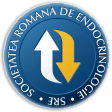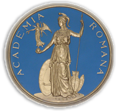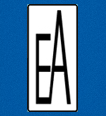
- Login
- Register
- Home/Current Issue
- About the journal
- Editorial board
- Online submission
- Instructions for authors
- Subscriptions
- Foundation Acta Endocrinologica
- Archive
- Contact
 Romanian Academy
Romanian Academy
 The Publishing House of the Romanian Academy
The Publishing House of the Romanian Academy

ACTA ENDOCRINOLOGICA (BUC)
The International Journal of Romanian Society of Endocrinology / Registered in 1938in Web of Science Master Journal List
Acta Endocrinologica(Bucharest) is live in PubMed Central
Journal Impact Factor - click here.

Showing 1 - 3 of 3
-
Endocrine Care
Yardimci E, Aysan E, Idiz UO, Akbulut H, Yigman S
What Should Be the Approach to Moderate Hypocalcaemia in the Early Period Following Total ThyroidectomyActa Endo (Buc) 2017 13(4): 437-440 doi: 10.4183/aeb.2017.437
AbstractContext. It is unclear whether treatment is necessary for transient moderate hypocalcaemia occurring after total thyroidectomy; if it is present, it is unclear which treatment modality should be preferred. Objective. To investigate both the necessity and effectiveness of different treatment approaches of oral and/ or intravenous calcium treatment in patients with transient, postoperative, moderate hypocalcaemia. Design. This is a case control study made between June 2014 and June 2015. Subjects and Methods. Forty-five patients who had serum calcium levels 6 hours after total thyroidectomy between 7.5-8 mg/dL were divided into three equal groups: an oral calcium administration group, an intravenous calcium administration group and a no-treatment group. Serum calcium and parathyroid hormone levels were measured preoperatively and on postoperative days 1, 2, 5 and 10. Results. For post-thyroidectomy patients with serum calcium 7.5-8 mg/dL in the early postoperative period, no significant difference in serum calcium or parathyroid hormone was detected between groups. Conclusions. Follow-up without treatment seems to be the most effective approach for moderate hypocalcaemia occurring in the early period following total thyroidectomy; this suggests that intravenous treatment should be avoided. -
General Endocrinology
Idiz C, Aysan E, Elmas E, Bahadori F, Idiz UO
Effectiveness of Anethum Graveolens L. on Antioxidant Status, Thyroid Function and HistopathologyActa Endo (Buc) 2018 14(4): 447-452 doi: 10.4183/aeb.2018.447
AbstractContext. Anethum graveolens L. is used in the treatment of numerous diseases. But there is limited data about the Anethum graveolens efficiency in thyroid tissue. Objective. The aim of this study is to assess the functional and histopathological changes in thyroid tissues from rats treated with Anethum graveolens L. extract. Design. This is an experimental animal study and duration of the study was 30 days. Subjects and Methods. Twenty-eight female Wistar Albino rats were divided into four equal groups. A gavage of Anethum graveolens L. extract at 0, 50, 150 and 300 mg/kg/day doses were given to the rats with 1 mL 0.9% NaCl, respectively, for 30 days. Blood was taken at day 0, 15 and 30. fT3, fT4, TSH values and antioxidant efficiency were observed. Also the thyroidectomy tissue was assessed histopathologically. Results. There is no difference observed in the fT3, fT4 and TSH values of groups 1, 2 and 3 at day 1, 15 and 30 (p>0.05); however, in group 4, TSH value decreased on days 15 and 30 when compared to day 1 and the other groups (p<0.05). Also the hypertrophy and thyroid follicular cell hyperplasia were significantly increased in group 4 (p<0.05). There is no difference in antioxidant efficiency in any of the groups (p>0.05). Conclusion. Anethum graveolens L. extract is effective on both the function and the histology of thyroid tissue but it has no effect on antioxidant status. -
Endocrine Care
Aysan E, Korkmaz YY, Hacihasanoglu E
A New Method for Intraoperative Definitive Diagnosis of Inadvertent Parathyroidectomy During Central Neck DissectionActa Endo (Buc) 2024 20(4): 490-493 doi: 10.4183/aeb.2024.490
AbstractBackground. The most serious complication of central neck dissection (CND) is inadvertent parathyroidectomy. There is no definitive method for intraoperative diagnosis of this complication. Method. We studied on CND indicated 17 thyroid cancer patients (14 female, 3 male, age range: 21-67, mean age: 43.4). The excised CND material was kept in 50 ml of normal saline for 30 minutes. A 2 ml sample was taken from this fluid and sent to biochemistry for rapid parathyroid hormone (PTH) measurement. Results. PTH values were <10pg/mL in 14 patients. PTH values of three patients were very high (112pg/mL, 167pg/mL, 210pg/mL respectively). When the excised tissue in these patients was evaluated intraoperatively with loop glasses, one parathyroid tissue was found in each of the three cases and these were auto-transplanted intramuscularly. After this procedure we kept CND tissue material again in another normal saline of 50mL in 30 minutes and PTH was measured. The values came back as <10pg/mL. No parathyroid gland was found in any case in the postoperative routine histopathological evaluation. No patient had symptoms of hypocalcemia during the eightweeks postoperative follow-up. Conclusion. Inadvertent parathyroidectomy due to CND is a serious complication. This complication can be prevented with the simple method we recommend here.
Showing 1 - 3 of 3